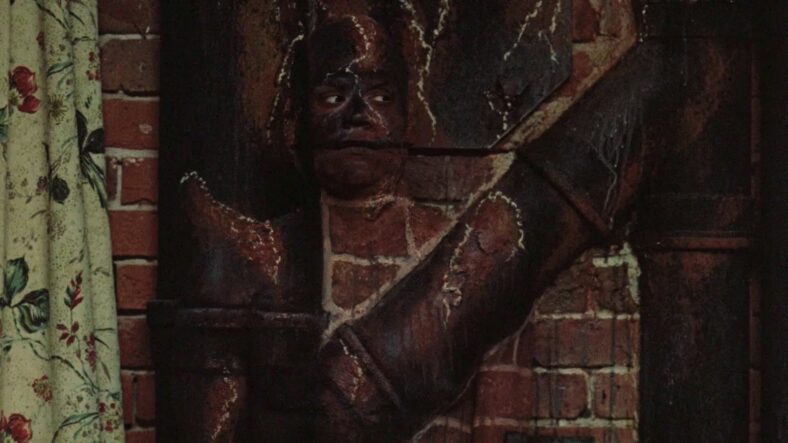
Fred Walton’s When a Stranger Calls features one of the most intense opening acts of any ‘70s horror film. Unfortunately, the picture meanders and loses its way in the second act, ultimately regaining some steam before the final showdown. Nonetheless, that opening is one for the history books. Walton returned to When a Stranger Calls in 1993 with When a Stranger Calls Back. The made-for-television horror sequel features a similarly jarring opening, a slightly more cohesive second act, and an absolute banger of a finale. The second franchise installment improves upon its predecessor, delivering a jump scare that blew my mind.
Here’s the plot synopsis:
When a Stranger Calls Back follows high school student Julia (Jill Schoelen) during a babysitting gig. She’s busy minding her own business, catching up on her studies, when a knock at the door changes everything. A voice on the other side of the door tells Julia that his car has broken down, and he needs to use the phone to call the auto club. Julia wisely declines to let the stranger in the house. Yet, when she attempts to place a call on his behalf, the line is dead. The intrusive visitor continues to taunt her, ultimately snatching the children out of their beds right underneath her nose.
Five years after that fateful night, Julia has enrolled in college and lives in an off-campus apartment. At this point, she thinks that night is behind her for good. But when inexplicable and strange things begin to happen to her, Julia worries that the mysterious caller is back at his old tricks. That’s when she teams up with Jill Johnson (Carol Kane) from the campus women’s center and Detective John Clifford (Charles Durning). Each has expertise in the type of terror with which Julia is dealing. Yet, try as they might, no one seems to be able to keep the young woman out of harm’s way.
When a Stranger Calls Back sees a final femme come full circle.
As a fan of the original, it’s satisfying to see Jill’s story come full circle here. It’s endearing to watch the now-grown Jill help a young woman who finds herself in a similar predicament. Maybe a bit too similar. However, this is a movie. Let’s not read too much into it and just have fun. The film is a lot of fun, after all. For horror fans, at least.
Much of what I love about this movie stems from expert-level tension-building and a strong script by Fred Walton. When a Stranger Calls Back is an intense, unnerving game of cat and mouse that features some epic jump scares and a sadistic antagonist. During the first act, the writer/director builds tension with foreboding shots that linger menacingly on the front door. In almost any other context, a front door would seem innocuous. However, Walton lingers on it to the point of extreme discomfort, silently shouting that danger lurks ahead. Each time he subsequently pans to the door, it becomes more and more ominous.
The film’s menacing villain will make your skin crawl.
Walton deserves props for writing a truly menacing antagonist with a sinister knack for getting under the viewer’s skin. The stranger cuts the phone lines to the house where Julia is babysitting. He knows the phone is out of order, but he repeatedly taunts her, asking her to place calls when he knows she can’t get a line out. Each time he asks is slightly more uncomfortable than the last. Especially when he begins to question her with a detectable level of doubt in his tone. It’s uncomfortable to watch. It’s awkward and frightening to experience his repeated torment from poor Julia’s perspective.
Walton uses multiple techniques to terrify the audience. Sometimes, he frightens us with what we see. Other times, the director sends chills down our collective spine with what we don’t see. Rather than show the viewer that the caller has found a way inside, we learn that he’s been in the house at the exact moment that Julia does. She goes to reference the notes she jotted down about the unwanted visitor’s auto club information and is jarred to learn that someone tore that page out of her notepad. It’s a chilling realization because we have no real reason to suspect the stranger has made his way inside. It comes as a rude awakening, for sure.
That jump scare, though.
The film meanders a little in the second act, but not as noticeably as its predecessor. The final 15 minutes more than make up for any minor missteps. They are unbearably tense. There’s a jump scare during the denouement that goes down as one of the most effective in 1990s horror. The moment when the viewer finally learns where the killer is located within Jill’s apartment (and that he’s actually hiding in plain sight) is so unexpected and so incredibly terrifying. The way he’s disguised himself to look like part of the brick wall (see below) is a stroke of evil genius. It’s further intensified when the intruder unexpectedly leaps into the frame, letting out a primal scream as he attacks Jill.

The first time I watched When a Stranger Calls Back, I jumped out of my skin during that jump scare. It blew my mind. A killer coming out of the woodwork (brickwork) is a brilliant idea that Walton and company execute with aplomb. Even on subsequent rewatches, that scene still gets me. It’s hard to believe something so eerily memorable originates from a TV movie.
If you haven’t yet experienced When a Stranger Calls Back, you should. Even if you’re only a casual fan of the original, this made-for-TV follow-up effort is a must-see. It surpasses its predecessor in almost every way. What’s more, you can check it out completely free as of the publication of this post. When a Stranger Calls Back is currently streaming on Tubi. Better yet, pick up the Scream Factory Blu-ray and you won’t have to rely on streaming availability when you want to rewatch the flick.
Categorized:Editorials

